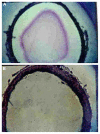Beta-amyloidolysis and glutathione in Alzheimer's disease
- PMID: 23650462
- PMCID: PMC3640603
- DOI: 10.2147/JBM.S35496
Beta-amyloidolysis and glutathione in Alzheimer's disease
Abstract
In this review, we hypothesized the importance of the interaction between the brain glutathione (GSH) system, the proteolytic tissue plasminogen activator (t-PA)/plasminogen/ plasmin system, regulated by plasminogen activator inhibitor (PAI-1), and neuroserpin in the pathogenesis of Alzheimer's disease. The histopathological characteristic hallmark that gives personality to the diagnosis of Alzheimer's disease is the accumulation of neurofibroid tangles located intracellularly in the brain, such as the protein tau and extracellular senile plaques made primarily of amyloidal substance. These formations of complex etiology are intimately related to GSH, brain protective antioxidants, and the proteolytic system, in which t-PA plays a key role. There is scientific evidence that suggests a relationship between aging, a number of neurodegenerative disorders, and the excessive production of reactive oxygen species and accompanying decreased brain proteolysis. The plasminogen system in the brain is an essential proteolytic mechanism that effectively degrades amyloid peptides ("beta-amyloidolysis") through action of the plasmin, and this physiologic process may be considered to be a means of prevention of neurodegenerative disorders. In parallel to the decrease in GSH levels seen in aging, there is also a decrease in plasmin brain activity and a progressive decrease of t-PA activity, caused by a decrease in the expression of the t-PA together with an increase of the PAI-1 levels, which rise to an increment in the production of amyloid peptides and a lesser clearance of them. Better knowledge of the GSH mechanism and cerebral proteolysis will allow us to hypothesize about therapeutic practices.
Keywords: Alzheimer’s disease; PAI-1; glutathione; plasminogen; t-PA.
Figures

Similar articles
-
Impacts of aging and amyloid-β deposition on plasminogen activators and plasminogen activator inhibitor-1 in the Tg2576 mouse model of Alzheimer's disease.Brain Res. 2015 Feb 9;1597:159-67. doi: 10.1016/j.brainres.2014.11.042. Epub 2014 Nov 29. Brain Res. 2015. PMID: 25454795
-
Amyloid-beta levels are significantly reduced and spatial memory defects are rescued in a novel neuroserpin-deficient Alzheimer's disease transgenic mouse model.J Neurochem. 2011 Sep;118(5):928-38. doi: 10.1111/j.1471-4159.2011.07359.x. Epub 2011 Jul 18. J Neurochem. 2011. PMID: 21689108
-
Plasmin system of Alzheimer's disease patients: CSF analysis.J Neural Transm (Vienna). 2012 Jul;119(7):763-9. doi: 10.1007/s00702-012-0778-y. Epub 2012 Mar 14. J Neural Transm (Vienna). 2012. PMID: 22415062
-
The probable role of tissue plasminogen activator/neuroserpin axis in Alzheimer's disease: a new perspective.Acta Neurol Belg. 2024 Apr;124(2):377-388. doi: 10.1007/s13760-023-02403-x. Epub 2023 Nov 2. Acta Neurol Belg. 2024. PMID: 37917293 Free PMC article. Review.
-
The plasminogen activating system in the pathogenesis of Alzheimer's disease.Neural Regen Res. 2021 Oct;16(10):1973-1977. doi: 10.4103/1673-5374.308076. Neural Regen Res. 2021. PMID: 33642369 Free PMC article. Review.
Cited by
-
Beneficial effects of levetiracetam in streptozotocin-induced rat model of Alzheimer's disease.Metab Brain Dis. 2022 Mar;37(3):689-700. doi: 10.1007/s11011-021-00888-0. Epub 2022 Jan 31. Metab Brain Dis. 2022. PMID: 35098412
-
Mitochondrial GSH Systems in CA1 Pyramidal Cells and Astrocytes React Differently during Oxygen-Glucose Deprivation and Reperfusion.ACS Chem Neurosci. 2018 Apr 18;9(4):738-748. doi: 10.1021/acschemneuro.7b00369. Epub 2017 Dec 14. ACS Chem Neurosci. 2018. PMID: 29172440 Free PMC article.
-
Multivariate association between single-nucleotide polymorphisms in Alzgene linkage regions and structural changes in the brain: discovery, refinement and validation.Stat Appl Genet Mol Biol. 2017 Nov 27;16(5-6):349-365. doi: 10.1515/sagmb-2016-0077. Stat Appl Genet Mol Biol. 2017. PMID: 29091582 Free PMC article.
-
Plasma Glutathione Levels Decreased with Cognitive Decline among People with Mild Cognitive Impairment (MCI): A Two-Year Prospective Study.Antioxidants (Basel). 2021 Nov 19;10(11):1839. doi: 10.3390/antiox10111839. Antioxidants (Basel). 2021. PMID: 34829710 Free PMC article.
-
Assessment and Validation of Globodera pallida as a Novel In Vivo Model for Studying Alzheimer's Disease.Cells. 2021 Sep 19;10(9):2481. doi: 10.3390/cells10092481. Cells. 2021. PMID: 34572130 Free PMC article.
References
-
- Delacourte A, Defossez A. Alzheimer’s disease: Tau proteins, the promoting factors of microtubule assembly, are major components of paired helical filaments. J Neurol Sci. 1986;76(2–3):173–186. - PubMed
-
- Flament S, Delacourte A, Hémon B, Défossez A. Characterization of two pathological tau protein, variants in Alzheimer brain cortices. J Neurol Sci. 1989;92(2–3):133–141. - PubMed
-
- Lee VM, Balin BJ, Otvos L, Jr, Trojanowski JQ. A68: a major subunit of paired helical filaments and derivatized forms of normal Tau. Science. 1991;251(4994):675–678. - PubMed
-
- Hasegawa M, Morishima-Kawashima M, Takio K, Suzuki M, Titani K, Ihara Y. Protein sequence and mass spectrometric analyses of tau in the Alzheimer’s disease brain. J Biol Chem. 1992;267(24):17047–17054. - PubMed
LinkOut - more resources
Full Text Sources
Other Literature Sources
Miscellaneous

